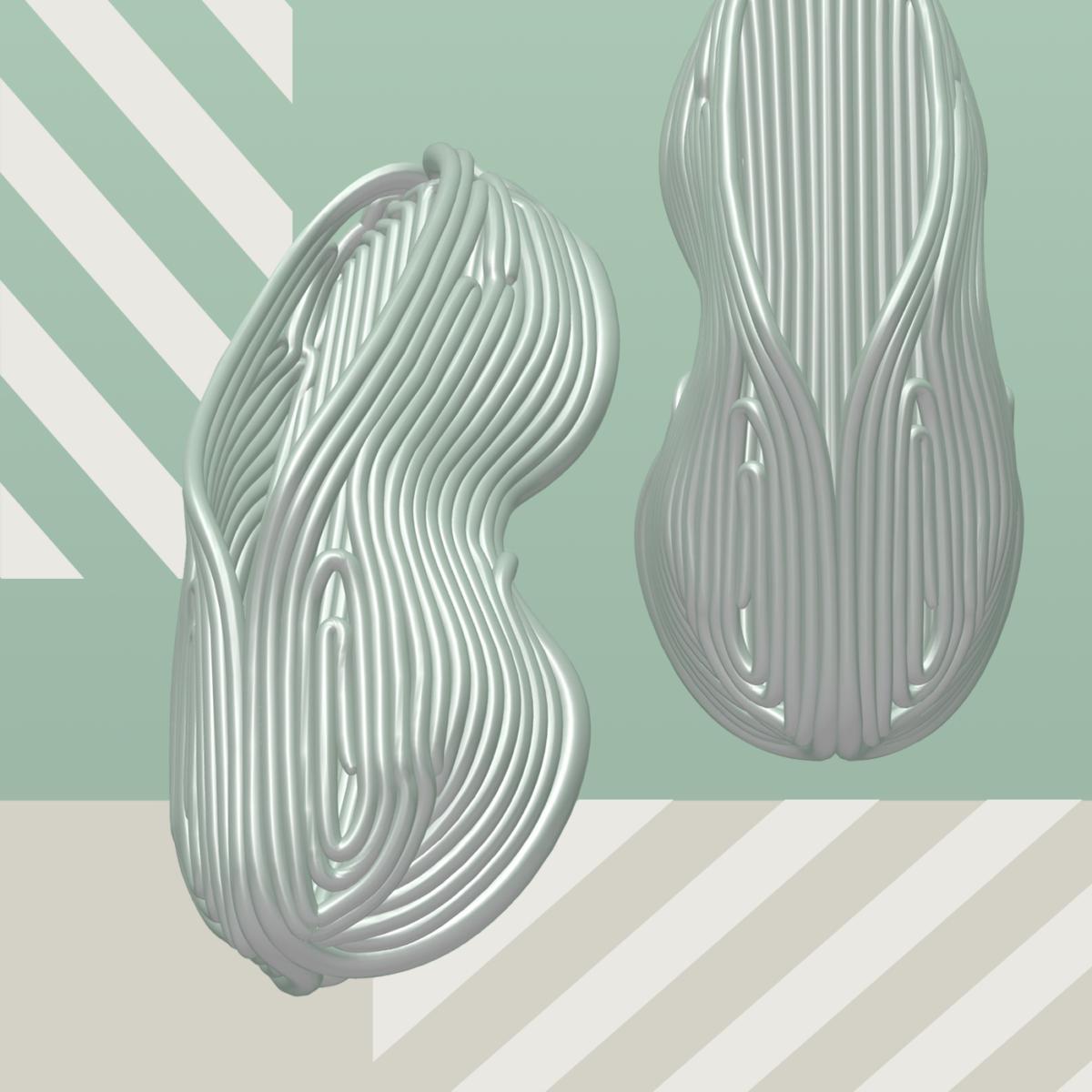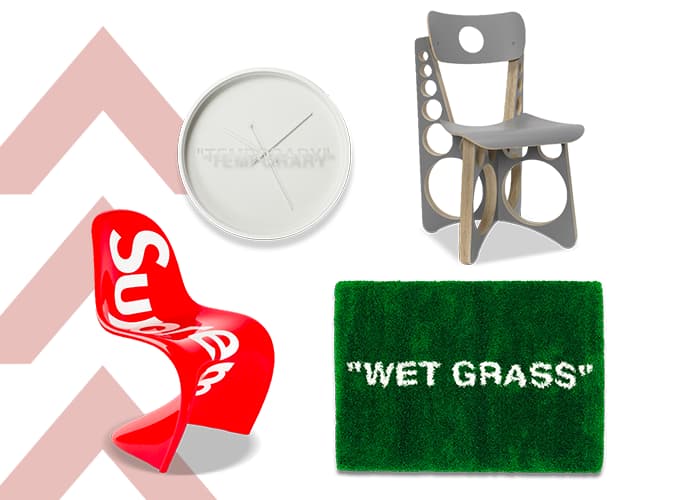A few months ago, my friend and creative partner texted me with a photo of a pair of sneakers—safety-orange slip-ons with a low ankle, rugged outsole, and reptilian texture stretched around most of the upper, with a link offering beta testing and a “custom fit” sneaker.
The shoes—the HERON01s—were the brainchild of forward-thinking designer Heron Preston and 3D-printed sneaker brand Zellerfeld, the latter of which crafts footwear from a pliable TPU polymer material. The HERON01 was but one piece of a larger picture that’s been coming into focus over the past year. 3D printing and its twin media, digital design (particularly VR), have advanced in ways that have intensely expansive potential for the worlds of apparel and furniture alike. In industries that have long been ruled by material limits and production costs, 3D printing and VR design offer a new vision for the future: empowerment, sustainability, and innovation outside of traditional large-scale business and production models.
Earlier this week, we explored the increasingly powerful intersection between furniture and fashion in What’s Design Got to Do With It?, investigating how these two disciplines actually have a longstanding history. It’s no coincidence that this is happening in conjunction with the rising popularity of 3D printing and VR design. With their emphasis on accessibility, independent makers with minimal budgets to think outside the box and blur the lines between our ideas of art, fashion, and design.
It may seem strange for industries that literally exist for the physical world, but virtual reality is gaining popularity as a primary design tool for both furniture and footwear. Gravity Sketch, a company self-described as “an intuitive 3D design platform for cross-disciplinary teams to create, collaborate, and review in an entirely new way,” has seen its usership rise, drawing designers in the furniture, auto, and sneaker design spaces, just to name a few.
The platform allows its users to simply sketch in VR using an Oculus system (and now the iPad), rather than following older methods of 3D design that used a complex but often confusing array of specific tools to accomplish particular tasks.
For Cullan Kerner, a 3D designer & content creator at Gravity Sketch, VR design allows him to jump seamlessly back and forth between furniture, object, and footwear design. Rather than VR creating more distance between the physical and the conceptual, Kerner sees it as a way to keep the user more in mind throughout the design process. “I think VR ultimately brings designers and artists closer to their three dimensional ideas—thus making them more ergonomically conducive with customers,” he explains. Both his sneaker and furniture designs prove this to be true, with pieces that curve to cradle the foot, body, or objects they hold—a fluidity that seems both organic and intentional.
“Using Gravity Sketch and virtual reality to design has revolutionized my entire process across numerous workflows, from furniture to footwear to architecture and other consumer wearables like hats, bags, jewelry, etc. The new challenge is to understand these new output capacities and change my perspective accordingly.” But VR design offers other benefits of equal significance to its creative potential. By designing in VR, creators are able to iterate more quickly and with less training, which has a democratizing effect especially impactful for those with less free time or financial resources. Though many designers choose to use tools like 3D printing to bring the digital to the physical, digital art markets like Exchange provide revenue sources for those who want to stick to the digital space.
For many, VR design is the future of the design process itself. “Virtually reality is the bridge that will inevitably connect our ideas to the physical goods we tangibly interact with on a daily basis in a more efficient and sustainable way,” says Kerner. “By empowering more people to create and thus creating more independent creators like myself, [it puts] the power in the hands of future makers.” The increasing use of VR design platforms like Gravity Sketch is likely due in part to the role and impact of 3D printing on various design industries. While VR brings ideas to life in new and accessible ways, 3D printing is often the key to making those ideas a physical reality. Though it’s been around for decades now, advances in 3D printing (or additive manufacturing as it’s often called) have made it more practical and accessible than ever. Sebastian Bidegain, a digital fabricator for well-known designer and sculptor Misha Kahn and founder of Voidfill Studio, credits big shifts in the industry for its popularity.
“The biggest strength to 3D printing is the ease in manufacturing a single object without the need for complex machinery or economies of scale,” explains Bidegain. “It has the advantage of infinite customization of objects, affordable one-offs, prototypes, and unique replacement parts.” The price also has its advantages. “Desktop FDM printers go for as cheap as $100, making it accessible to most people wanting to get into it.” Like with VR design, removing many of the barriers to entry typically associated with design and production processes is revolutionizing markets for industries like furniture and footwear. “A strength that 3D printing adds to manufacturing is a high degree of customization and ease in making one-offs,” shares Bidegain.
“With furniture design, customization appears as either for the body [or ergonomics of the piece], or customization for the manufacturing process. Customized apparel can be made to fit a 3D scan of a body part, [like a] customized fit for shoes.” For 3D printing manufacturers like Zellerfeld, the custom fit is what sets the product apart from large scale manufacturers: using 3D scanning tech allows for shoes made just for you. Balenciaga has famously made use of the tech to print heels, seen here being unboxed by Kylie Jenner.
But when it comes to furniture and decorative objects, 3D printing isn’t just limited to the plastic material we typically associate with the manufacturing process, but can be used to print with “ceramic, concrete, metal, and even food,” a benefit Bidegain highlights in the advantages of the industry. Artists and designers like Jolie Ngo have used 3D printing to redefine their media of choice. Ngo, whose work incorporates 3D printed ceramics, creates objects that put a futuristic spin on an ancient art form.
In both the VR and 3D printing worlds, the emphasis and excitement is on empowerment. Both processes challenge our ideas about what design can be, what we can make, and how we can share ideas with the world. For industries like furniture and footwear that have longstanding traditions and often rigid business models, the potential for independence and innovation offer a glimpse at how design will transform in the coming years. For now, the sky (both digital and physical) is the limit.
David Eardley is a creative director, writer, and curator working in New York and Mexico City. He is the founder of Pink Essay, a creative studio and platform re-designing design culture through exhibitions, experiences, and archives. David’s curatorial work includes the OPEN STUDIO, Physical Education: Parallax 101, and Physical Education II: Design for All design exhibitions with Pink Essay, as well as his independently curated Home Around You and Unidades Materiales art and design exhibitions. David’s work and writing have been featured across The Wall Street Journal, Architectural Digest’s Clever, Office Magazine, Cloakroom Magazine, New York Magazine’s The Strategist, CURBED, and I-D.




